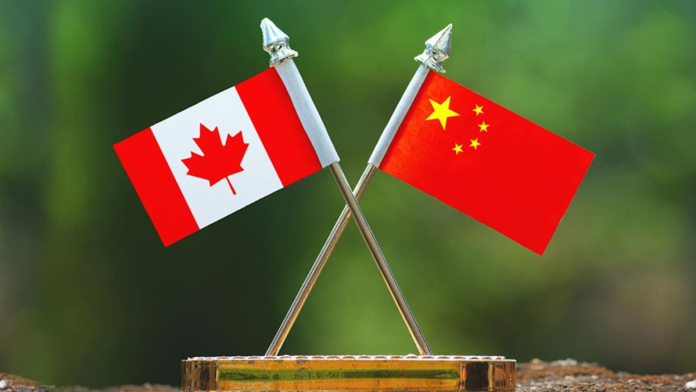China and Canada are showing signs of repairing their relationship after years of tension and diplomatic silence. The change comes as both countries face growing pressure from the United States and seek to balance economic and political challenges.
Canadian Foreign Minister Anita Anand visited Beijing for two days of high-level meetings with Chinese Foreign Minister Wang Yi. It was the first visit to China by a Canadian foreign minister since Donald Trump returned to the White House. The meeting was described by both sides as a “fresh start” aimed at restoring trust and reopening dialogue at all levels.
Wang Yi said Beijing was ready to restart communication and cooperation, advance the settlement of mutual concerns, and put China-Canada ties back on the track of stable and sustainable development. He emphasized that both countries had broad areas for cooperation and could fully become partners if they focused on practical collaboration.
Anand noted that Prime Minister Mark Carney placed high importance on rebuilding ties with China and was committed to recalibrating relations. She said the momentum for improvement was positive and that progress had already been made in restoring constructive exchanges between the two sides.
China blocks business with 5 U.S. subsidiaries of Hanwha Ocean in trade dispute
Her visit followed Carney’s meeting with Chinese Premier Li Qiang on the sidelines of the United Nations General Assembly in New York, where both agreed to keep dialogue open. Beijing was the final stop on Anand’s Indo-Pacific tour, which also included India and Singapore.
Trade and Diplomatic Challenges
Trade has been a central issue in China-Canada relations. The two countries have imposed tariffs on each other’s goods in recent years, straining what was once a robust partnership. Canada introduced heavy tariffs on Chinese electric vehicles, steel, and aluminium, mirroring Washington’s trade measures. In retaliation, China imposed 100 per cent tariffs and anti-dumping duties on several Canadian agricultural products, including canola.
During Anand’s talks in Beijing, both ministers discussed agriculture, electric vehicles, and ways to cooperate constructively in clean energy and trade. According to the Canadian foreign ministry, the discussions were aimed at identifying shared interests despite ongoing trade disputes.
Money-laundering storm engulfs Toronto-Dominion Bank, shaking Canada’s image of financial stability
Analysts say Ottawa’s recent actions represent a pragmatic shift in its China policy. With the U.S. escalating trade tensions, Canada is seeking to diversify its partnerships to protect its economy. Expert Jia Wang from the University of Alberta noted that Anand’s visit is building momentum for a possible meeting between Carney and Chinese President Xi Jinping, describing the exchanges as a reflection of mutual interest in restoring communication and practical cooperation.
Thomas Liu of the Institute for Peace and Diplomacy in Toronto said many Canadians want more diversified trade ties and opportunities. He added that Ottawa’s recent diplomatic approach deserves recognition for responding to that public sentiment.
From Past Friction to Renewed Dialogue
Relations between China and Canada deteriorated sharply during Trump’s first presidency, when Canada accused China of cyber-espionage and political interference. The 2018 arrest of Huawei executive Meng Wanzhou in Vancouver under a U.S. extradition warrant caused a diplomatic freeze that lasted several years. High-level engagement was suspended, and trust eroded further.
Ukraine’s defense strengthened by Trump’s daring fund backed by Chinese import levies
Tensions resurfaced at the 2022 G20 summit in Bali when Xi Jinping confronted then-Canadian Prime Minister Justin Trudeau over media leaks about their private discussions. In addition, Canada’s decision last year to send a naval frigate through the Taiwan Strait drew strong criticism from Beijing.
Under Carney’s leadership, Ottawa has continued to navigate a complicated landscape. Washington’s tariffs on Canadian goods have hurt the economy, while Trump’s public remarks describing Canada as America’s “51st state” have created additional friction. The U.S. purchase of stakes in Canadian critical mineral companies also raised security concerns in Ottawa about foreign involvement in strategic sectors.
At the same time, Beijing has faced its own challenges with Washington. Trump recently threatened new 100 per cent tariffs on Chinese goods in response to restrictions on rare-earth exports and higher shipping fees. Experts such as Josef Gregory Mahoney from East China Normal University said these circumstances make this a ripe time for Canada to re-engage with China. He noted that while Beijing is cautious, both sides recognize the need to restore dialogue and rebuild basic trust.
Despite unresolved differences on issues like human rights and security, analysts agree that China and Canada are taking small but meaningful steps toward mending ties. The current diplomatic exchanges show that both sides are willing to set aside past disputes and focus on stability and cooperation after years of tension.


